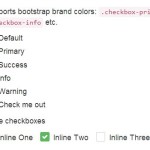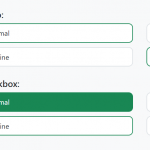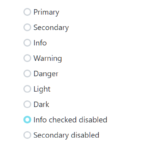| Author: | msisto |
|---|---|
| Views Total: | 17,715 views |
| Official Page: | Go to website |
| Last Update: | September 1, 2014 |
| License: | MIT |
Preview:

Description:
Helps you create nice checkboxes and radio buttons with Google material design inspired ripple/wave effects. Built only with CSS/CSS3. Created by msisto.
How to use it:
Add a group of checkboxes and radio buttons into your document.
<label> <input type="checkbox" class="option-input checkbox" checked> Checkbox 1 </label> <label> <input type="checkbox" class="option-input checkbox"> Checkbox 2 </label> <label> <input type="checkbox" class="option-input checkbox"> Checkbox 3 </label> <label> <input type="radio" class="option-input radio" name="example" /> Radio option 1 </label> <label> <input type="radio" class="option-input radio" name="example" /> Radio option 2 </label> <label> <input type="radio" class="option-input radio" name="example" /> Radio option 3 </label>
The CSS to restyle the checkboxes and radio buttons.
.option-input {
-webkit-appearance: none;
-moz-appearance: none;
-ms-appearance: none;
-o-appearance: none;
appearance: none;
position: relative;
top: 13.33333px;
width: 40px;
height: 40px;
-webkit-transition: all 0.15s ease-out 0;
-moz-transition: all 0.15s ease-out 0;
transition: all 0.15s ease-out 0;
background: #cbd1d8;
border: none;
color: #fff;
cursor: pointer;
display: inline-block;
outline: none;
position: relative;
margin-right: 0.5rem;
z-index: 1000;
}
.option-input:hover { background: #9faab7; }
.option-input:checked { background: #40e0d0; }
.option-input:checked::before {
width: 40px;
height: 40px;
position: absolute;
content: '\2716';
display: inline-block;
font-size: 26.66667px;
text-align: center;
line-height: 40px;
}
.option-input:checked::after {
-webkit-animation: click-wave 0.65s;
-moz-animation: click-wave 0.65s;
animation: click-wave 0.65s;
background: #40e0d0;
content: '';
display: block;
position: relative;
z-index: 100;
}
.option-input.radio { border-radius: 50%; }
.option-input.radio::after { border-radius: 50%; }The CSS3 rules to create Material Design styled ripple/wave effects using keyframes.
@-webkit-keyframes
click-wave { 0% {
width: 40px;
height: 40px;
opacity: 0.35;
position: relative;
}
100% {
width: 200px;
height: 200px;
margin-left: -80px;
margin-top: -80px;
opacity: 0.0;
}
}
@-moz-keyframes
click-wave { 0% {
width: 40px;
height: 40px;
opacity: 0.35;
position: relative;
}
100% {
width: 200px;
height: 200px;
margin-left: -80px;
margin-top: -80px;
opacity: 0.0;
}
}
@-o-keyframes
click-wave { 0% {
width: 40px;
height: 40px;
opacity: 0.35;
position: relative;
}
100% {
width: 200px;
height: 200px;
margin-left: -80px;
margin-top: -80px;
opacity: 0.0;
}
}
@keyframes
click-wave { 0% {
width: 40px;
height: 40px;
opacity: 0.35;
position: relative;
}
100% {
width: 200px;
height: 200px;
margin-left: -80px;
margin-top: -80px;
opacity: 0.0;
}
}










Doesn’t work on Firefox.
Anyone know a workaround for Firefox? The issue, apparently, is non-recognition of pseudo elements (:before, :after) on input elements.